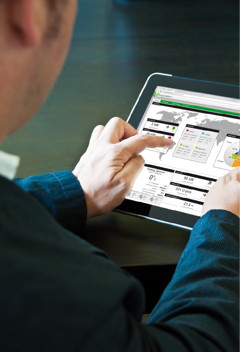How software can enable and secure Internet of everything

The hardware of building management system and the Internet of Things is merely an enabler for software, as Simon Garratt of Schneider Electric explains.
The Internet of Things (IoT) is spurring the trend toward intelligent, data-rich buildings and creating a wealth of new opportunities in facilities of all types. With a trove of previously untapped data at their fingertips, energy and facility managers are acquiring more insight into their infrastructure and using it to drive tangible improvements in energy efficiency, employee comfort and productivity.
However, the presence of advanced sensors to capture, communicate, and analyse crucial operational data is only half the battle. To reap the rewards of this data, the processes for data capture, analysis and reporting become all-important. Smart buildings now require a wide range of software, computing ecosystems of gateways and the cloud — as well as the unification of building automation and power management systems.
Software is the linchpin of the IoT revolution. In order to operate, connected devices must be tied together in a way that enables communicative connectivity. This means businesses must have the right software in place to facilitate communication with the building management system (BMS).
Much of a BMS’s inherent value rests upon the quality of software within it. When considering the solutions to invest in, companies are placing a premium on software that has the potential to expand connectivity to new areas, extending it beyond the building control system. They recognise that, as is the case in nature, a closed system cannot truly thrive.
Data on weather, electricity pricing and predictions of occupancy levels are just some of the areas where superior software can boost a building’s performance and cut operational costs. For example, knowing when occupancy levels are reduced, building operators can program the BMS to put part of a building into a temperature setback. This has the potential to create annual savings of up to 10% in heating and cooling a year, with more savings possible with changes to lighting and ventilation.
More sophisticated predictive modelling is also possible when coupled with quality software. To illustrate, the energy consumption trend of a building or process can be analysed to help avoid peak-demand penalties or uncover spare capacity. By modelling energy needs with weather and utility rate data you can optimise energy purchasing, participate in a demand response program, or work out the best times of day to consume onsite renewables.
The growth of the IoT is also enabling new service-based models of software. Facility teams can not only access cloud-based performance tracking and analytic tools, but can also share those with service providers offering maintenance, efficiency upgrades, or other expertise.
By increasing its scope of connections, a business opens itself up to a range of potential advantages. With the best software installed, a facility’s connected devices work in harmony— allowing the BMS to enhance and improve the communication capabilities of sensing, control, and automation hardware to direct automated and manual improvements to operations.
Many benefits come from leveraging the IoT to connect and enhance control systems. However, the presence of these connected devices and their proximity to the BMS make them a tantalising target for cyber criminals. Lacking the security applications found on company laptops and PCs, connected devices such as sensors, can appear as soft targets for opportunistic hackers. In the event of a cyberattack, these devices can be used as backdoors to acquire confidential data from the wider network or as a way to hijack part of the building operations.

As cybercrime becomes a growing problem for almost all industries, it has become crucial for connected devices, cloud platforms and analytics layers to be protected. Fortunately, software once again holds the key.
For the purpose of defence, many companies are increasingly turning to security software such as network intrusion detection systems (NIDS) and dynamic endpoint modelling.
NIDS monitors for attacks from users acting within the network. Suspicious activity creates alerts that are then managed by systems analysts or cyber security teams, who determine the best course of action.
Dynamic endpoint modelling is a more recent technology that learns the behaviour of network devices and triggers an alert when it detects anomalies.
A great part of what makes a BMS valuable for enterprise is the software contained within it, and the nature and quality of that software impacts the management system enormously. Business is catching on to this. Direct software spending will grow to 11% of all IT spending by 2018 according to Gartner. The tally becomes even higher when software-related services are accounted for.
Ultimately, the IoT will be defined by the new degree of operational intelligence and efficiency it delivers. Today, it is helping managers gain deeper understanding, boost performance and comfort, cut costs, streamline maintenance and plan for a more sustainable future. Yet this is only made possible by software that enables connectivity and secures the network.
If the IoT is the locomotive of business success, software is the glue holding it all together.
Simon Garratt is field services manager with Schneider Electric.







